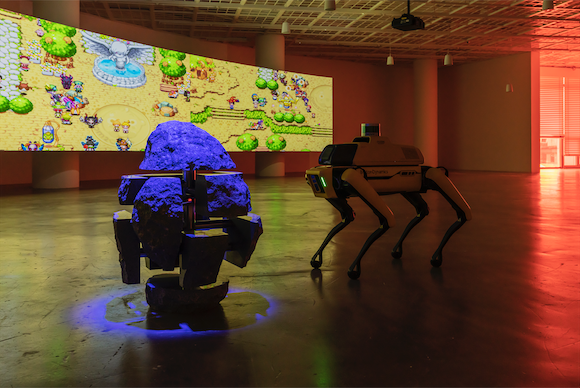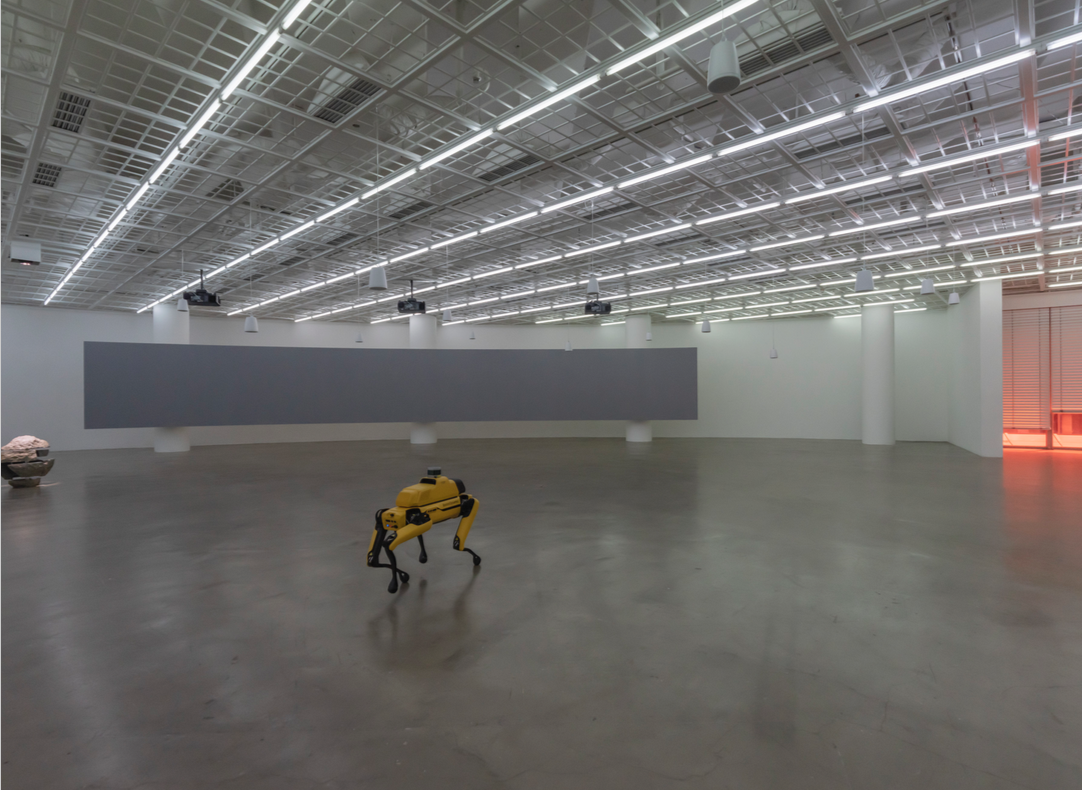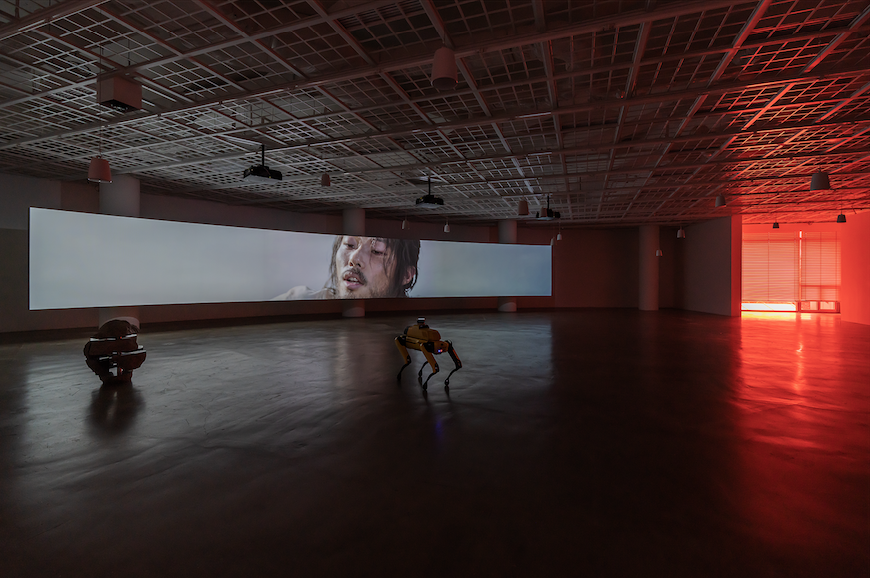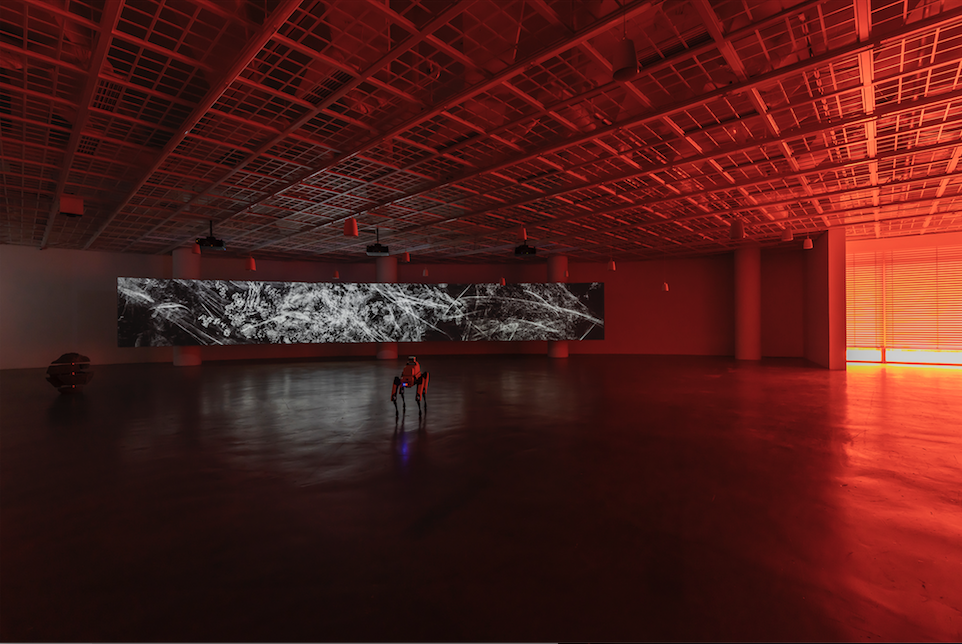To build a Fire






예술이 빌려오는
시선이 동물과 식물을 거쳐 광물에 이르렀다. 전시장 왼편에
놓인 돌은 지구 위에 ‘한때’ 살았던 인간이라는 존재를 과거
시제로 기억한다. 그 추억의 어조는 차갑다. 앞서 말한 것처럼
인간의 어리석음과 자기 파괴적인 측면을 설명하기 때문이다.
돌의 시간대에서 인간의 등장과 퇴장은 요란했으나 그의
지속은 길지 않은 것이었다.
반면 무대 오른편에는 노란색 로봇 개가 있다. 전시의 시작은,
정확히 말하자면, 돌의 내레이션에 앞서 로봇 개가 전시장
한가운데로 오면서부터이다. 그가 관람객에게 다가와 스크린을
향해 몸을 돌리면, 관람객은 그와 함께 나란히 정면의 영상을
감상하게 된다(로봇 개를 ‘그’라고 불러도 되는지, 아니면 다른
적합한 대명사가 있는지 모르겠다).
이 작품에서 로봇 개의 위상은 복합적이고 수시로 변한다.
그는 작품의 관객으로 시작하지만, 관람객의 시선을 유도하는
안내자가 되었다가, 돌과 대화하는 주인공이 되기도 한다.
그리고 그는 이번 전시 내내 탄소를 측정해 그 데이터를
연구소로 보내는 ‘서울 웨더 스테이션’의 중심 역할을 수행한다.
작품 내내 돌은 쉬지 않고 말하고, 로봇 개는 능숙하게
움직인다. 관람객은 말을 광물에 내어주고 운동을 로봇에
빼앗긴 채, 인간 고유의 능동성을 상실한 기분이 든다.
“인간들도 여타 다른 종들과 마찬가지로 비탄과 절망 속에서
사라졌다. 그것은 영원함을 꿈꾸던 무지한 종의 필연적이고도
전혀 새로울 것이 없는 전형적인 결말이었다. 다만 다른 종의
종말과 다른 것이 있었다면 인간들의 운명은 그들 자신의
손에 있었다는 것이다. 그렇지만 어리석게도 그것을 몰랐던
그들은 결국 종말을 맞이했고, 그 결말을 이루게 한 것은
그들에게 익숙했던 동족 간의 살육이 아닌 그들의 삶과
체제가 지속 가능할 것이라는 망상과 자만심이었다. 인간들은
그들이 이 땅의 유일한 창조물이라 생각하고, 세계의 만물과
다양한 생명체를 그들의 대척점에 두고 다스리려 했다.
그들은 물을 오염시키고, 땅을 죽이며, 하늘을 질식하게
만들어 그들 스스로 파국을 초래하였다.”
The perspectives invoked in art have now gone beyond the animal and vegetable to the realm of the mineral. The stone situated to the left side of the exhibition setting recalls humans in the past tense as beings who “once” lived on Earth. The tone of its reminiscence is cold. As mentioned be- fore, this is a description of human beings’ foolish and self-destructive qualities. Within the stone’s time frame, human beings made a noisy entrance and exit, but they did not last for long.
To the right of the stage is a yellow robot dog. More precisely, the exhibition begins before the stone’s narration starts, when the robot dog arrives at the center of the gallery. As he approaches the view- ers and orients his body toward the screen, the viewers join him in watching the video that un- folds before them. (I’m not sure whether the robot dog should be called “he,” or whether some other pronoun would be more appropriate.)
The role of the dog in this work is complex and changes periodically. He starts as a viewer, but he also becomes a guide directing the viewers’ gaze, as well as a participant in the conversation with the stone. Throughout the exhibition, he plays a key role in the “Seoul Weather Station” as he measures carbon dioxide data, which he sends to researchers. The stone never stops speaking in this work, and the robot dog moves adroitly. The viewers may feel as though they have lost their agency as human beings, ceding speech to the stone and movement to the robot.
“Humans, like other species, have disappeared in grief and despair. It was an inevitable and completely new ending to an ignorant species that dreamed of eternity. However, if there was anything different from the end of other species, humans had their fate in their hands. But foolishly unaware of it, they eventually came to an end, and it was the delusion and conceit that their lives and systems would be sustainable, not the bloodshed that they were accustomed to. Humans thought they were the only creatures on the earth and tried to rule with all the world's things and various life forms at their opposite points. They polluted the water, killed the land, and choked the sky, causing themselves to collapse.”